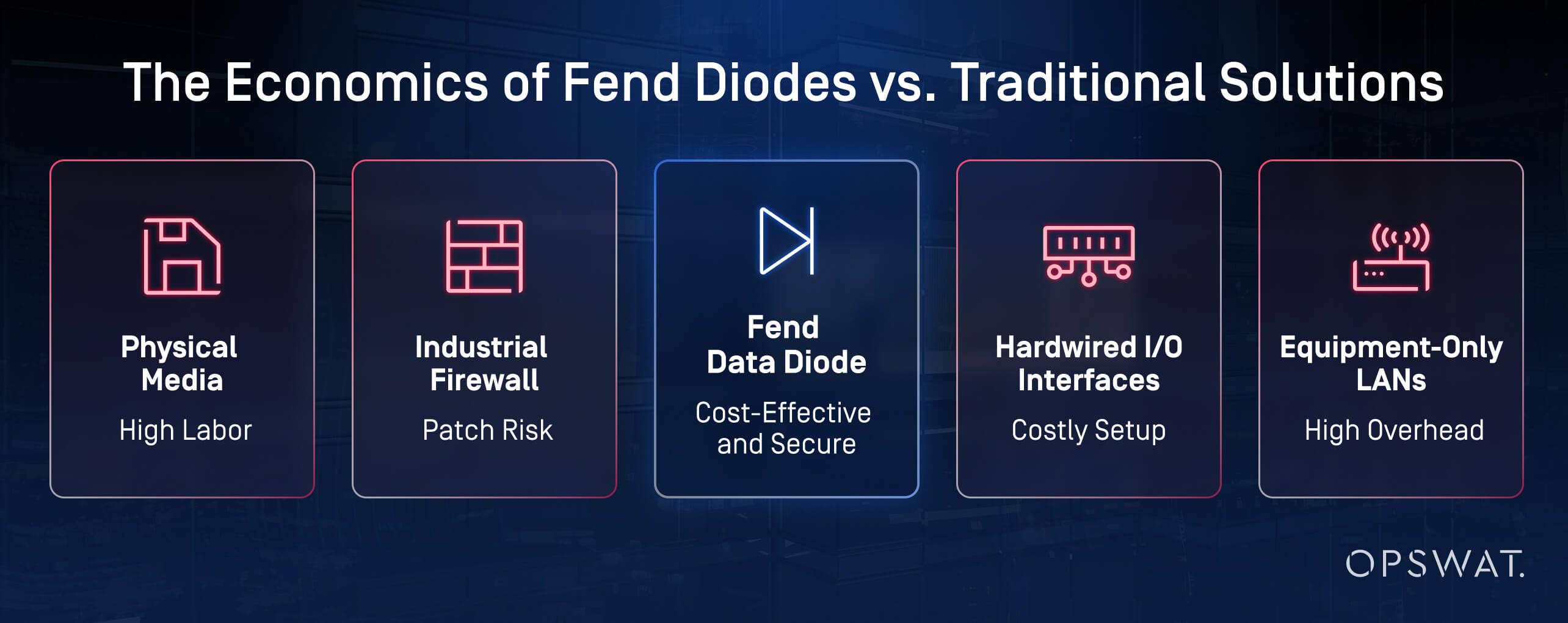You may already know that data diodes provide greater security than firewalls and are more practical than living with air gaps but did you know they can quickly pay for themselves?
The best security can also be the most cost effective, thanks to OPSWAT’s line of Fend data diodes that are built from the ground up to be secure, rugged, and affordable. This combination matters; not just to small businesses and local communities, but to lots of other cost-conscious organizations looking to do more with each available dollar.
Among these, the US Department of Defense, needing to secure some 2 billion industrial endpoints from cyberattack, was looking for something new that could simplify security and improve the economics of cyber defense.
DoD Had a Data Acquisition Problem
In order to run an organization that includes the US Navy, Army, Air Force, and Space Force, you need a lot of equipment. Not just planes and tanks, but the buildings that help service this equipment, feed the troops, and provide power and water at home and on the front lines.
With some 250,000 buildings and structures alone, maintenance teams needed more than a little help understanding which systems needed attention right now. To help provide some visibility into the health of these systems, OT environments across the DoD (Department of Defense) are becoming increasingly interconnected. This means that the need for secure, scalable, and cost-effective cybersecurity measures has never been more urgent.
An analysis by DoD’s Environmental Security Technology Certification Program (ESTCP) did a thorough evaluation of OPSWAT’s low-cost, easy-to-use Fend data diodes which offer a compelling solution—one that meets rigorous DoD cybersecurity requirements while slashing costs traditionally associated with air-gapped systems and secure data acquisition.
Ironclad Security Backed by DoD Testing
Before getting to the economics, the testing teams needed to verify performance of the Fend data diode technology. OPSWAT’s Fend data diodes enforce unidirectional data flow using a hardware-based optical pathway, physically isolating critical systems from cyberthreats originating on lower-security networks. This approach mirrors the protections used to guard nuclear facilities—without the prohibitive cost.
But can the technology be just as effective at blocking threats at a fraction of the expense?
In adversarial penetration tests conducted by the Army’s TSMO (Threat Systems Management Office) and the Navy’s CSTB (Control Systems Test Bed), OPSWAT’s Fend diodes successfully defended against reverse communication, tampering, and disruption. Additionally, Nessus vulnerability scans found zero critical issues—affirming the diode’s hardened security profile and its suitability for DoD use cases.
Cost Efficiency That Pays for Itself
As covered in depth by the full report by the DoD’s ESTCP, it’s clear that Fend’s data diodes were more cost effective for many use cases than legacy, IT-focused data diode systems that can cost over $100,000 per connection and often require complex customization. OPSWAT’s Fend diodes, by contrast, are right-sized for facility and equipment monitoring—delivering comparable security at a fraction of the price. This next generation OT diode technology competes head-to-head against other cybersecurity approaches and delivers return on investment in as little as six months compared to manual data retrieval. industrial firewalls, and other data acquisition methods.
| Technology | Security Considerations | Cost Comparison | Payback/Breakeven vs. Fend Diode |
|---|---|---|---|
| Transport of physical media | Manual transport introduces human error; disks/drives can be lost; data can be stale | Labor-intensive; $2,100 to $10,000 annually for transport and retrieval | 0.5 to 2.4 years |
| Hardwired control ‘points’ and I/O interfaces | Risk of side-channel attacks; electrical wiring could be exploited | High initial costs per point; $30,000 to $50,000 typical installation | Immediate — Fend diode significantly cheaper |
| Separate equipment-only LAN | Physical segmentation must be maintained; bridging risks exist | High wiring costs, $5,000 to $12,500 per facility plus fiber for connections | Immediate — Lower first cost and similar annual cost |
| Industrial Firewalls | Vulnerable to misconfigurations and unknown threats; requires patching | Upfront $3,000 plus $600 to $2,000 annual patching/licensing fees | 1 to 4 years for new install; 2.5 to 8.3 years if replacing existing tech |

1. Compared to Physical Media Transport (e.g., DVD Burning, Hard Drive Retrieval)
Many facilities today still rely on manual processes such as daily DVD burning or USB/hard drive transport to collect data from air-gapped systems. While extreme cases like international data retrieval can cost over $5,000 per trip, the more common scenario—daily or weekly media handling—adds up quickly in labor costs alone.
- Burning a DVD daily for data transfer consumes ~5 minutes of labor per day, totaling about $2,190 annually (at $72/hour labor rate).
- In some performance contracts, engineers physically retrieve drives every few months, adding thousands in travel and labor costs per trip.
Fend Diode Payback
Often under 1 year, simply by eliminating manual tasks—even faster if frequent media swaps are involved.
2. Compared to Industrial Firewalls
Industrial firewalls may seem like an affordable option at first, but they require constant upkeep:
- Typical upfront cost: $3,000–$5,000.
- Ongoing annual costs: $600 to $2,000 for security updates, patching, and licensing.
- Also vulnerable to misconfigurations and only protect against known threats.
Fend Diode Payback
- 1 to 4 years compared to new firewall installations.
- Even faster in environments where frequent patching labor or breach risk mitigation factors.
3. Compared to Hardwired I/O Interfaces (Physical Control Points)
Hardwired solutions transmit data over physical wiring, which is expensive and inflexible:
- Common costs: $300 to $500 per point, adding up to $30,000–$50,000 for medium-sized facilities.
- These systems still pose some risk of side-channel attacks and can be difficult to scale or reconfigure later.
Fend Diode Payback
Immediate—typically far cheaper for the same or better functionality, with added flexibility for future needs.
4. Compared to Dedicated Equipment-Only LANs
Some organizations attempt to create isolated LANs for secure monitoring:
- Estimated costs: $5,000 to $12,500 per facility for in-building networks, plus potential costs for fiber installation between sites (average $27,000 per mile).
- Maintaining segmentation over time can be challenging and expensive.
Fend Diode Payback
Immediate or near-immediate for facilities requiring cross-building or remote data transfers.
Easy to Deploy, Built for Scale
Beyond security and cost, OPSWAT Fend data diodes are designed for rapid deployment. Most installations are completed in under an hour by standard maintenance personnel—no specialized training required. They support a wide range of industrial protocols (BACnet, Modbus, LonTalk, FTP), and come in compact, ruggedized form factors suitable for harsh environments.
A Diode for Every Use Case
For applications where secure, one-way data transfer is appropriate—such as equipment status monitoring, energy usage reporting, or predictive maintenance—OPSWAT’s Fend data diodes provide both uncompromising protection and significant cost savings. They are a proven, scalable solution ready to modernize cybersecurity across the DoD and critical infrastructure sectors alike.



